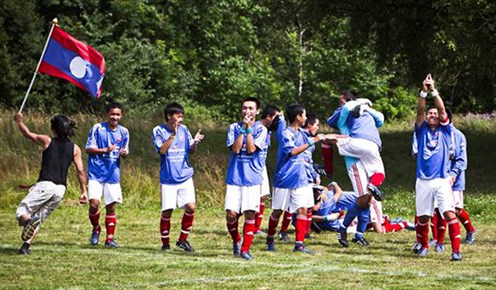04 April 2014
When the Ground Isn't Safe
Playing Football in the Shadow of Cluster Bombs
 Mini and his friends in sweden ©Per Friske
Mini and his friends in sweden ©Per Friske
19-year-old Mini Phanthavong is a talented football player from Phonsavan, a town about 400km north of Laos’ capital Vientiane. At the age of 16, he joined his football-playing friends on an incredible journey to Sweden, where they competed in the largest youth football tournament of the world.
Playing football in Sweden is different from playing in Laos. Not only is Sweden on the other side of the world and has it got lots of lush flat grass to play on; in Sweden Mini did not have to fear kicking the ball off the football pitch into a cluster bomb contaminated area.
Laos is the country most heavily affected by cluster munitions in the world. Between 1964 and 1973 the US dropped at least 270 million cluster bomblets. Of those, it is thought that 80 million failed to explode as they fell on the ground.
When we spoke with Mini he told us that he is well aware of the dangers of cluster munitions in his region. “I remember learning about bombs since I was a little child. My parents and all people around me always told me what bombs are. They told me to be careful and stay away from bombs. When I was in second year of primary school UXO Lao came to my school to tell about bombs and how dangerous they are.”
“With every step that I walk outside of the marked pathway, I am always concerned and scared of UXO [Unexploded Ordnance, such as cluster munitions]. I hear about the victims of UXO frequently, especially farmers on their farm land.”
However hard he tries, sometimes taking the risk and stepping into an area of land that has not been cleared of bombies (the way many people in Laos refer to cluster bombs) seems unavoidable for Mini. “When we kick the ball into a bush or the forest lawn, we have to go out of the playing field to collect the ball.”
In the area of Phonsavan, contamination by cluster bomb remnants is severe – to the extent that you might even find a cluster bomb where you should feel most safe, at home. Ten years ago, Mini’s family discovered a bomb in their backyard, after they had been living in that house, and playing in that garden for four years without finding the bomb until that point.
Mini and his family were lucky to escape, but many people are less fortunate. Mini tells us about a man who got hurt by a cluster bomb while digging soil on his farmland. “A villager heard the sound and brought him to the hospital. He lost his hands.” As for many cluster bomb victims, the accident took away the man’s livelihood.
Today, on the International Day for Mine Awareness and Assistance in Mine Action, Cluster Munition Coalition campaigners worldwide will highlight the terrible legacy of use of cluster munitions and call on governments to take action. In London, the Cluster Munition Coalition, in collaboration with the filmmaker Gareth Carter and the Swedish Embassy will show the film On Safer Ground. The film shows the journey that Mini and his team members make to compete in the Gothia cup in Sweden and the power of sport to overcome the challenges faced by the legacy of war in Laos.
Laos is a State Party to the 2008 Convention on Cluster Munitions that prohibits the use, transfer and stockpiling of cluster bombs. The convention also obliges States Parties to clear contaminated land within ten years from the entry into force of the convention. Laos is obligated to have cleared its land by 2020. But due to the excessive amount of contamination in Laos, it is expected that this deadline will not be met.
With the international support needed for clearance, Laos and other countries affected by cluster munitions could be cleared within Mini's lifetime.


